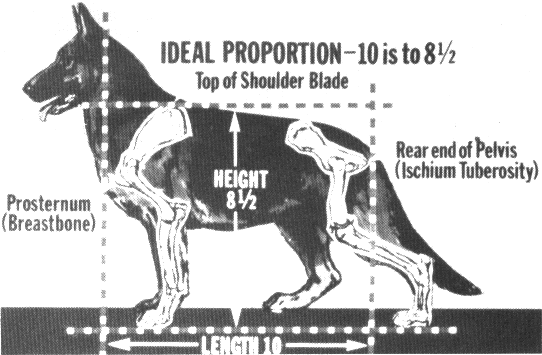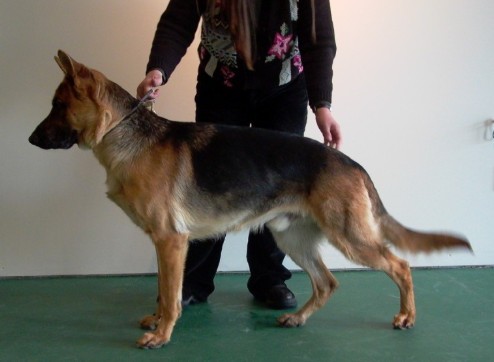from the
German Shepherd Dog Club of America
I have spent the past 20 years studying the GSD standard, going to dog shows to see winning dogs, and learning from accomplished breeders, but the things that have influenced me the most have been the many structure seminars I have been to from both German SV judges and AKC judges. What is interesting to me is that while these judges may explain exactly what the standard is, the reason behind the standard, and it relationship to FUNCTION, I have not seen the same standard applied to the dogs in the show ring. This is especially true of the AKC show ring. One of the most influential seminars I attended was from Patricia Trotter called FORM and FUNCTION. It was an intensive training that dealt with exactly how each form of structure helped the dog to function in its intended task.
This is especially subjective in the German Shepherd Dog. I have attached the link to the Illustrated Standard for the German Shepherd from the American GSD Parent Club. It is so clear about what the structure should be, yet there are very few dogs out that that meet that standard. It is so difficult to say here, in brevity how vitally important this standard is to the proper function of the dog.
Several times, I had a conversations with someone wanting to know if I bred "frog dogs" and that they wanted a dog that had a square structure, large with straight backs, more commonly referred to as "BOX" dogs or Old World German Shepherds. Frog Dogs refers to the dogs whose hocks are not clean and straight in movement, and whose rear end is so over angulated that the dog drags his back feet or lands on his hocks like a rabbit might. He also was referring to the "roach" of the European dogs.
If you STUDY the illustrated standard, the German Shepherd is intended to be a MEDIUM size dog, not a large dog. The reason for this is that the larger the dog, the more quickly the dogs joints will break down, the less endurance, and less natural ability the dog will have with the hard work the dog is intended to do - sheep herding - which includes miles and miles a day of trotting. Secondly, "box" dogs tend have very straight back legs, which do not allow them the full range of movement. They are unable to reach fully forward to grab the earth, then follow through behind in "drive". If the dog does not have some angulation to his croup, this simply, structurally cannot happen.
In my own observations and in conversations with veterinary orthopedic surgeons, straight back legs and knees also contribute to torn ACL knee ligaments which usually require expensive surgery to repair so the dog can function without pain. Costs for that surgery are approximately $2,000 give or take geographically. When we see the correct rear angles as described in the standard, we will find that it includes a nice "turn of stifle" - that knee joint which allow the knee joint (ACL) more cushion in movement and less stress on the ACL . Box type structure or "old world style" dogs are more likely to have joint failures and a lessened working life due to their size and due to the common straight rear legs.
People also equate hip health with structure, which is indeed part of hip health. But, they forget GENETICS - generations and generations of healthy hips. It is not enough to have strong structure, the dog must also have generations of healthy hips behind him/her. This is where research on the www.pedigreedatabase.com is very helpful as well as the Orthopedic Foundation for Animals www.offa.org. In both places, you can trace your intended puppy parents and their genetic history with regard to hip and elbow health.
In order to have healthy hips, the dog must have both proper FORM or STRUCTURE and Excellent GENETICS. Do NOT overlook one for the other.
There is a contemplative reason for the Standard. You CANNOT have proper function without proper form. In my opinion, it is most clearly explained in the Illustrated Standard in the link above. I have tried to compare the standard to some of my dogs below so you can more clearly visualize what that means in real life.


The dog to the right is Evandar Mestari v Brostrom at 18 months old, my now retired stud dog and competitive tracking dog. He is son of German World Sieger VA Lasso von Neuen Berg SchH 3. His mother was VA5 Jessie v Blickfeuer SchH2. Both from European bloodlines. If you draw the angles on both is back end and the front end, you can see the the structure is nearly identical to the standard. Evandar, however was larger than the standard standing at 29 inches and weighing between 94 and 104 depending on his activity. His hips were OFA GOOD and PennHip'd in the 50 percentile. You can trace his pedigree and hip genetics through the pedigree data base.

In this comparison is my current stud dog, Brinx von Kearanen PT. He is a puppy from my breeding in 2007. He is son of VA Kevin v Murrtal SchH3 and Mavis v Bullinger BH CGC. Brinx has OFA GOOD hips and is PennHip'd in the 90 percentile, which is almost unheard of and extremely healthy. This stack is not exactly perfect. He was standing in a field filled with a flock of sheep and very excited about that! His front end is a little "pegged" meaning the front legs are a bit too far forward. His shoulder would look even more impressive if the stack was just a bit more relaxed and over his front legs more. Brinx' hip health and genetics can be traced back many generations through the pedigreedatabase and the OFFA.org website. Below is a photo of Brinx and his structure in action, doing what he was bred to do, sheep herd.